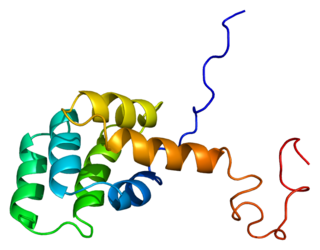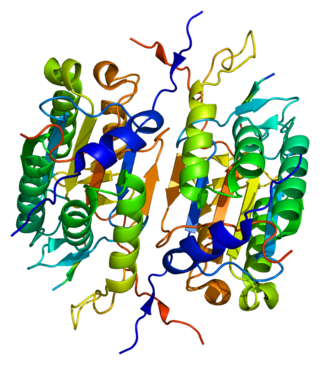
The Fas receptor, also known as Fas, FasR, apoptosis antigen 1, cluster of differentiation 95 (CD95) or tumor necrosis factor receptor superfamily member 6 (TNFRSF6), is a protein that in humans is encoded by the FAS gene. Fas was first identified using a monoclonal antibody generated by immunizing mice with the FS-7 cell line. Thus, the name Fas is derived from FS-7-associated surface antigen.

Caspase 2 also known as CASP2 is an enzyme that, in humans, is encoded by the CASP2 gene. CASP2 orthologs have been identified in nearly all mammals for which complete genome data are available. Unique orthologs are also present in birds, lizards, lissamphibians, and teleosts.

Baculoviral IAP repeat-containing protein3 is a protein that in humans is encoded by the BIRC3 gene.

Death receptor 4 (DR4), also known as TRAIL receptor 1 (TRAILR1) and tumor necrosis factor receptor superfamily member 10A (TNFRSF10A), is a cell surface receptor of the TNF-receptor superfamily that binds TRAIL and mediates apoptosis.

Caspase-10 is an enzyme that, in humans, is encoded by the CASP10 gene.

Calpain-2 catalytic subunit is a protein that in humans is encoded by the CAPN2 gene.

Calpastatin is a protein that in humans is encoded by the CAST gene.

MAP kinase-activating death domain protein is an enzyme that in humans is encoded by the MADD gene.

Baculoviral IAP repeat-containing protein 1 is a protein that in humans is encoded by the NAIP gene.

G2 and S phase-expressed protein 1 is an enzyme that in humans is encoded by the GTSE1 gene.

Leucine-rich repeats and death domain containing, also known as LRDD or p53-induced protein with a death domain (PIDD), is a protein which in humans is encoded by the LRDD gene.

Cell division cycle and apoptosis regulator protein 1 is a protein that in humans is encoded by the CCAR1 gene.

GAS2-like protein 1 is a protein that in humans is encoded by the GAS2L1 gene.

E3 ubiquitin-protein ligase RNF34 is an enzyme that in humans is encoded by the RNF34 gene.

Growth arrest-specific protein 7 is a protein that in humans is encoded by the GAS7 gene.

Ubiquitin conjugation factor E4 A is a protein that in humans is encoded by the UBE4A gene.

Bcl-2-like protein 12 is a protein that in humans is encoded by the BCL2L12 gene.

Etoposide-induced protein 2.4 homolog is a protein that in humans is encoded by the EI24 gene.

Caspase activity and apoptosis inhibitor 1 is a protein that in humans is encoded by the CAAP1 gene.

FYVE, RhoGEF and PH domain-containing protein 2 (FGD2), also known as zinc finger FYVE domain-containing protein 4 (ZFYVE4), is a protein that in humans is encoded by the FGD2 gene.























